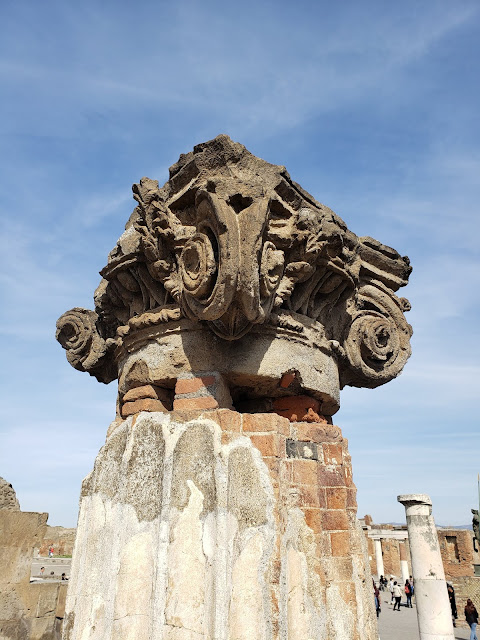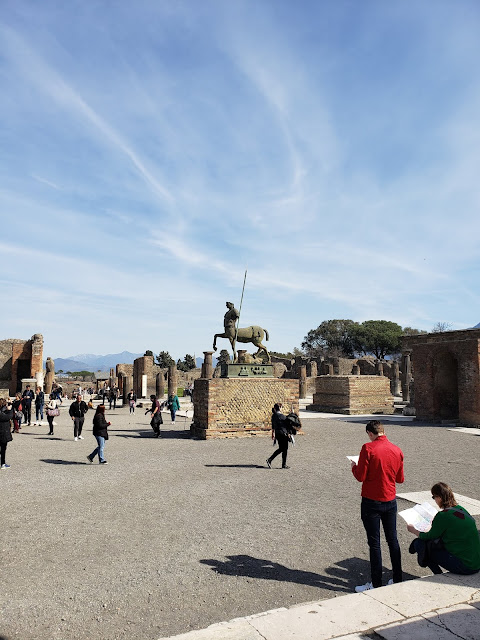A Day in Pompeii, Italy
Around 79AD the ancient city of Pompeii was destroyed by the volcanic eruption of Mount Vesuvius. The eruption was so violent that the entire city and it's over 20,000 inhabitants was lost forever. Buried under 13-20 feet of volcanic ash much of the city structures were preserved allowing modern day archeologists to uncover and gain valuable insight into the everyday lives of the citizens of the city. Not only was much of the infrastructure left in remarkable condition but many of the beautiful frescos, flooring, and art survived. A more gruesome sight was discovered when some bodies of the city's inhabitants were unearthed preserved in a cast of ash.
For many years I have looked forward to seeing Pompeii and on this day I took a train from Rome to finally be able to walk the city and see it for myself. This experience exceeded my expectations. The city is well preserved, and after the entrance fee of $16 euros you gain entrance to walk and explore all of the streets and buildings of the ancient city.
Pompeii has a rich history and I highly recommend you research it a little before you arrive to enhance your experience. At the entrance gate are guides offering walking tours and you may want to invest in one. This day I was fortunate enough to meet a young American University student that was in Italy studying classical history. She shared all she knew about the ancients of Pompeii and the city itself. She even read and translated the latin inscriptions that survive around the city. I can't thank her enough for taking the time to share her knowledge and stories.
The history of Pompeii you can certainly research on your own, but here I will share my photos of my fantastic day wandering the ancient city of Pompeii and I strongly recommend that you make it a stop on your next visit to Italy.
Pompeii was much larger than I had expected and I walked for hours and still want to go back again and explore it further.
Enjoy!
Yours truly in the 'House of the Fawn'.
Floor mosaic depicting Alexander the Great in battle.
The Pompeii Forum.
Lainey, Classical History Major, in her element studying in person the civilization that she had only read about until this day. She knows her ancient history.
Thanks for being a wealth of knowledge and sharing your time to make this a great experience for me!
Pompeii in the shadow of Mount Vesuvius.
These round receptacles are all over the city and it was believed they held coins, merchandise, jewelry, and other items of value.
In many of the buildings the original mosaic floors are in perfect condition and illustrate how beautiful this city must have been.
Beautiful wall frescoes survived in fantastic condition.
The streets of Pompeii are laid out and engineered in true Roman fashion. Water would have flowed in the streets and at every intersection large 'crossing stones' were placed to allow pedestrians to cross the streets without getting wet. Gaps between these stones were strategic to allow for wagons to pass without obstruction also.
Water flowing was instrumental to the success of the city and it's many inhabitants living and working in such close quarters within the city walls.
Pompeii had two amphitheaters. Pictured here is the smaller more intimate one used for plays, and other performances of the day.
Pompeii has many famous buildings and pictured here is the inside of one it's most notable. Pompeii's famous brothel. Murals on the wall survived to illustrate what would have been scenes playing out inside one of the many bed chambers.
Pompeii was dug out from under nearly 20 feet of volcanic ash and stones.
As archeologists uncovered the city human remains encased in volcanic ash like full size body casts were discovered along with remains of animals.
The Romans usually designed their streets in grid patterns so seeing this made me stop and think.
The train station of Pompeii.





































































Comments
Post a Comment
Hi. Leave a comment.